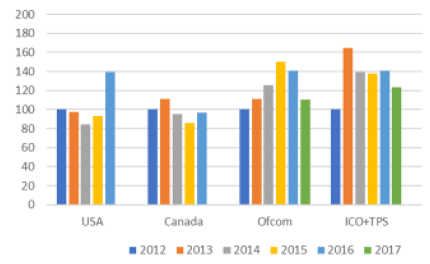Effectiveness of actions to reduce harm from nuisance calls in Scotland
Research commissioned to analyse the impact of actions set out in the Nuisance Calls Commission action plan, and to examine the outcomes of past interventions.
1 Introduction
This report is the main deliverable from a project commissioned by the Scottish Government [1] , with the aims of:
- estimating the effectiveness of different actions to reduce the impact of nuisance calls in Scotland;
- investigating how the Scottish Government can measure and monitor the outcomes of its Scottish Nuisance Calls Action Plan published on 11 September 2017 [2] .
Available evidence relates mainly to the UK, so we start by looking at the effectiveness of such actions for the UK [3] . We then look at how the situation in Scotland differs from the rest of the UK, and estimate the likely effectiveness of actions in the Action Plan. We continue with a section on how the Scottish Government can measure and monitor the outcomes of the Action Plan, and close with conclusions and recommendations.
The Scottish Government Nuisance Call Commission defined its scope in relation to:
“Unwanted phone calls that attempt to promote a product, service, aim or ideal that can cause the recipient a range of harm, from annoyance to lasting detriment, including emotional or financial damage.”
In this paper, we use the term “nuisance calls” to include all such unwanted calls. By “scam calls” we mean the subset of these which are made with criminal intentions. Many nuisance calls are illegal, being in breach of regulations (or in the case of scam calls, of criminal law). However, some calls comply with all the rules but may still be unwanted, and which calls are unwanted will vary for different people. A more detailed classification of these and other types of call, along with indications of their likely incidence, is provided in Annex A.
The available evidence relates mainly to nuisance calls to landlines. The report focuses on these, for this reason and also because of particular concern about nuisance calls to people living with dementia, who tend to be elderly and to have landlines rather than mobiles. But nuisance calls and texts to mobiles are a growing problem, also worthy of attention.
There have been many activities in recent years aiming at reducing the impact of nuisance calls in the UK. We discuss these activities (and potential extensions to them) under three main headings:
- Reducing the number of nuisance calls made to UK recipients.
- Preventing recipients from receiving nuisance calls made to them.
- Minimising harm caused by nuisance calls received.
A full study of how best to achieve any of these objectives would naturally consider the cost and difficulty of the actions concerned, as well as their effectiveness. These aspects are outside the project Terms of Reference, but occasionally creep in.
At the time of this study, in the second half of 2017, enforcers pointed to a clear fall from 2016 to 2017 in UK nuisance calls complaints, which is not reflected in North America, as illustrated in Figure 1. In its monthly enforcement update for September 2017, ICO offered these reasons for the fall:
- Successful investigations and enforcement action by the ICO preventing further breaches.
- Call blocking and SMS spam technology are playing a part in reducing the impact of unsolicited marketing. Analysis of our data shows an increase in complaints about calls that have been intercepted by call blockers.
- OFCOM revised its Persistent Misuse Policy 2016 and, since January 2017, has adopted a more strategic approach to tackle and reduce automated nuisance calls by working with telecoms providers.
Figure 1: Nuisance calls complaints trends

Note: All figures are indices based on 2012=100. Sources are published statistics from the regulators, plus informal information for 2017 from Ofcom.
Calendar years are used for UK bodies and reporting years for USA ( FTC) and Canada ( CRTC).
2017 figures for ICO+ TPS and Ofcom are extrapolated to a full year from the first half of 2017.
If maintained, and supported by other indicators, this fall is indeed an encouraging development, which suggests that the Scottish Action Plan has good chances of success.
The project has a strong focus on evidence of effectiveness. To get the best possible picture, we have drawn on all the data sources we could find.
Figure 2 summarises key features of our most important data sources; section 4.3.1 and Annex H provide fuller accounts.
Figure 2: Key features of selected data sources
| Data source | Positive features | Reasons for caution |
|---|---|---|
| Complaints statistics | Should directly reflect consumer perception of harm. | Figures are highly variable; complaint rate (per problem) is low, and affected by publicity, complainant fatigue and difficulty in complaining. |
| Ofcom landline nuisance call diary surveys | Systematic counts by representative user samples, done consistently for 4 weeks in each of 5 years. | Counts depend on diarists’ recall and commitment; sample sizes limit disaggregation of findings. |
| Ofcom consumer issues omnibus surveys | Done 3 or 4 times per year. Covering mobiles as well as landlines. | Respondents are asked whether they received nuisance calls in the past four weeks, requiring them to recall and estimate. |
| trueCall unit records | Large samples, and complete automatic record for each unit providing data. | Results represent the experience of trueCall customers, rather than all landline customers. |
| Other surveys from e.g. Which?, BT | Supplementary evidence throwing light on special aspects. | Survey design and reporting reflect the commissioning organisation’s own objectives. |
Contact
There is a problem
Thanks for your feedback